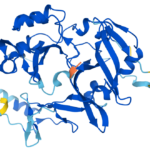Who hacked the slaughterhouse? When robots and AI take over farms
By Susan D’Agostino | May 23, 2022
 Cow. Credit: Roboiitgrs. Accessed via Wikimedia Commons. CC BY-SA 3.0.
Cow. Credit: Roboiitgrs. Accessed via Wikimedia Commons. CC BY-SA 3.0.
Security analysts warned the US Agriculture Department in May 2021 that a cyberattack could produce more chaos in the food supply chain than COVID-19. Less than a month later, JBS, the world’s largest meat processor, was hit by a Russia-linked ransomware attack that crippled its plants that produce nearly one-quarter of US beef and food for other countries. JBS paid $11 million in bitcoin to reestablish itself as a critical link in the food supply chain. Then, a few months later, hackers demanded $5.9 million from New Cooperative, an Iowa grain co-op whose computer network manages the feeding schedule of millions of chickens, pigs, and cows. Dozens of malware and ransomware attacks like these have targeted food manufacturers, processors, and packagers in recent years. And last month, the FBI issued a new alert that cybercriminals are now targeting farms and food producers during critical planting and harvest seasons.
Agriculture today faces many challenges, including climate change, labor shortages, small margins, and supply chain problems caused by the war in Ukraine and COVID-19. Online data systems like those at JBS and New Cooperative promise to ameliorate some of these challenges by boosting productivity. Sensors that record and transmit agricultural data over the internet help farmers make decisions that might increase their yields at minimal cost. Artificial intelligence (AI) can be used to detect patterns in agricultural data that help reduce expensive inputs like fertilizer while maximizing crop yields. These advanced technologies, in turn, may help feed the more than two billion people around the world who struggle with food insecurity.
Yet swift adoption of these technologies may leave computer-aided food systems vulnerable to hacking, according to a recent paper published in Nature Machine Intelligence. Designers of robots and AI in agriculture should assess the risks and establish protocols for problems that can be reasonably anticipated. If not, their inventions may intensify socio-economic inequality and harm the environment.
“If the advantages of AI in agriculture are explicit, so should be [their] associated possible adversities,” Asaf Tzachor, lead author of the paper, said.
The benefits and risks of autonomous robots and AI in farming. AI and autonomous robots hold potential to be a boon for agriculture. AI, for example, may detect and diagnose plant diseases early, after which algorithms can direct autonomous robots to treat problems. It can predict weather and crop yields, helping farmers plan. It can also automate tilling, planting, fertilizing, monitoring, and harvesting. In most of these tasks, it outperforms humans in processing, synthesizing, and analyzing real-time agricultural data relevant to farmers’ decision making. Also, algorithms can regulate drip-irrigation grids, command fleets of topsoil-monitoring robot swarms, and supervise weed-detecting rovers, self-driving tractors, and combine harvesters, according to Tzachor. These practices often conserve resources, save labor, minimize loss, and increase revenues.
But many of these systems rely on the internet, which means that hackers can attempt to disrupt these digitized food supply chains. Cyberattacks can interfere with AI-driven machinery designed to harvest, inspect crops, or apply fertilizer and pesticides. Such attacks may affect every link in the food supply chain, including growth, processing, and distribution.
“I’m fascinated with the notion of progress traps,” Tzachor said of his motivation for the research, “…dynamics in which implementing a promising technological fix to one problem inadvertently prompts a novel and far more wicked problem.”
Sometimes a threat, whether inadvertent or intentional, comes from within. For example, before a self-driven machine can head out to a field, it must be programmed by a human who is susceptible to making mistakes. An entire crop may suffer if a program directs an autonomous robot to apply an inadequate amount of water or too much of an herbicide, pesticide, or fertilizer. Even when a device performs as intended, a poor design may leave a food system vulnerable. For example, wireless sensors that detect pests and robots that apply chemicals may be programmed in such a way that prioritizes short-term crop productivity over the long-term health and integrity of the environment. Automated tilling, which is known to harm topsoil, may exacerbate soil erosion. In short, AI’s narrow focus on agricultural yields may, in fact, ignore problems with pests, biodiversity, and pollution, according to the study.
Who reaps the benefits of AI and robots in agriculture? Some agricultural AI relies on data kept by national and international research institutions. This data must be relevant to be useful. But decades’ worth of this institutional data has focused on staple crops from wealthy countries such as wheat, rice, and corn, according to Tzachor’s study. Large data sets focused on crops like quinoa, cassava, and sorghum produced by low-income, subsistence farmers around the world are much harder to find. Similarly, indigenous farmers’ sustainable approaches to planting, pest control, and harvest are often overlooked.
“Small-scale growers who cultivate the majority of farms worldwide and feed large swaths of the so-called global south are likely to be excluded from these AI-related benefits,” Tzachor said. Even if the relevant data existed, many small farmers live in remote regions where the internet access on which digitized farming relies is poor. As a result, the burgeoning use of artificial intelligence in agriculture may widen the gap between commercial and subsistence farmers.
In some cases, the private sector and NGOs have partnered with underserved agricultural regions to help minimize this technology gap. In sub-Saharan Africa, for example, more than 60 percent of the land consists of small farms and 23 percent of the GDP hails from agriculture. In Ghana, the private Farmerline Group has funded technology that supports distribution networks. “We think of ourselves as the Amazon of farmers… a digital and physical infrastructure powering a marketplace that allows the movement of goods and services to and from rural areas,” Alloysius Attah, Farmerline’s co-founder, told TechCrunch. For his efforts, Attah was named a 2021 Bloomberg New Economy Catalyst.
Still, even farmers with access to digitized tools are encountering problems, according to Diana Moss, president of the American Antitrust Institute. Farmers who sign technology agreements with big agricultural biotech companies often sign away their rights to the data, leading to what’s known as a “closed cropping system.”
“The closed cropping system basically says, ‘Look, you get to use Monsanto products only. Or you get to use Dow products only,’” Moss said of farmers’ choices for the proprietary seeds, chemicals, and more that go hand-in-hand with corporate data collection. “The big ag biotechs are engineering their cropping systems to be non-interoperative with rival technologies.”
Once farmers are locked into a company that holds their data, both farmers and consumers will pay higher prices, Moss said: “It contributes to a very, very fragile agricultural supply chain.”
How can the risks of automated agriculture be minimized? Advanced technology in agriculture is not inherently bad and is poised to deliver benefits. That said, problems arise when humans fail to predict and prevent the unintended consequences of its use.
“Much like in the digital tech sector with Facebook, Amazon, and Google, it’s all about having just a few or a single dominant player with really strong incentives to use data to control competition, to the detriment of growers and consumers,” Moss said. “Merger control and strong antitrust enforcement is really the starting point for controlling all of this.”
CGIAR, a global research partnership of agricultural research institutes, encourages the use of findable, accessible, interoperable, and reusable—FAIR—data principles. Farmers should be able to own their data and share it at their discretion, without compromising their privacy or introducing security risks. But democratizing data in this way requires sophisticated cooperatives. Brookings has recognized efforts worthy of emulation, including Twiga Foods in Kenya and the Tanihub Group in Indonesia, both of which are at work digitizing the small-farm-to-table supply chain.
Tzachor and his team also suggest the use of “digital sandboxes” in which researchers and farmers can assess risks and make recommendations for oversight before the systems go live. The HandsFree Hectare at Harper Adams University, for example, operates a hybrid cyber-physical space in which they test for unintended consequences.
Rural anthropologists, applied ecologists, ethicists, and data scientists should also be invited to collaborate with computer scientists who are at work developing robots and AI for agriculture, Tzachor suggests. This may act as an insurance policy against environmental harm and socio-economic inequities resulting from their use.
Last month, the FBI warned the food and agricultural sector that cybercriminals are now timing their attacks on the industry to coincide with critical seasons such as planting and harvesting. Such attacks may increase the victims’ willingness to pay ransom, given that any delay could result in an unrealized or spoiled harvest. The FBI recommended steps to prevent cyberattacks, such as backing up data, using multifactor authentication and strong passwords, updating antivirus and antimalware software, and designing a recovery plan.
“Some 50 malware and ransomware attacks targeting food manufacturers, processors and packagers were registered over the past two years,” Tzachor said while acknowledging that none to date have been catastrophic. “That may be attributed to the fact we have not yet delegated a great deal of autonomy to machines to administer our farms.”
Together, we make the world safer.
The Bulletin elevates expert voices above the noise. But as an independent nonprofit organization, our operations depend on the support of readers like you. Help us continue to deliver quality journalism that holds leaders accountable. Your support of our work at any level is important. In return, we promise our coverage will be understandable, influential, vigilant, solution-oriented, and fair-minded. Together we can make a difference.















